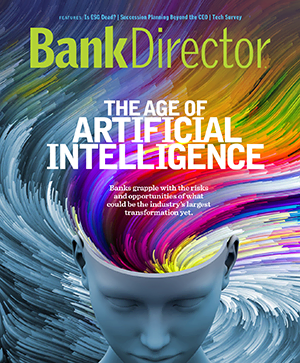Laura Alix is the Director of Research at Bank Director, where she collaborates on strategic research for bank directors and senior executives, including Bank Director’s annual surveys. She also writes for BankDirector.com and edits online video content. Laura is particularly interested in workforce management and retention strategies, environmental, social and governance issues, and fraud. She has previously covered national and regional banks for American Banker and community banks and credit unions for Banker & Tradesman. Based in Boston, she has a bachelor’s degree from the University of Connecticut and a master’s degree from CUNY Brooklyn College.

2025 Technology Survey: Banks Grapple With Data, AI Maturity
Bank Director’s 2025 Technology Survey examines decision-making, data strategies and how banks are using artificial intelligence.
Brought to you by Jack Henry & Associates, Inc.

Community banks have access to troves of valuable customer financial data, but many bankers admit they don’t always know how to make the best of it. In Bank Director’s 2025 Technology Survey, sponsored by Jack Henry & Associates, one-third of bank leaders cite an inability to use data effectively as a top challenge facing their bank when it comes to its use of technology.
A deeper dive into the survey results reveals persistent problems for the industry when it comes to managing data that could have broader implications as banks seek to compete and embrace new solutions.
In order to effectively use many emerging technologies, including artificial intelligence, banks need to organize and clean their data so they’re not relying on incomplete or redundant information. Bank CEOs, chief operating officers, senior technology executives and board members participating in the survey say their institutions employ a variety of methods to manage their data. Fifty-six percent keep data in the system or platform that generates or uses it, and an equal percentage rely on their core provider to access data. Forty-one percent use spreadsheets to manage data used by business lines, and 39% use a data lake or warehouse to combine data from different sources.
“Relying on spreadsheets to manage data is not only cumbersome and inefficient, it introduces vulnerabilities around governance, data integrity, security and compliance,” says Jennifer Geis, senior strategic advisor of research and payments with Jack Henry.
An inconsistent approach to data management reflects a larger underlying problem at some banks, where much work happens in silos and isn’t communicated holistically throughout the organization, says Lee Wetherington, senior director of corporate strategy with Jack Henry. “All banks have multiple systems of record for different kinds of data, but until you aggregate the data from those systems in one place, you don’t have a single source of truth to drive reliable analysis, automation, AI and strategic decision-making across the bank.”
Some banks are tackling this challenge. Twenty-eight percent of all respondents say their institution has invested in data analysis platforms or capabilities over the prior 18 months, a percentage that climbs to 70% for banks over $10 billion in assets.
Half of respondents believe their bank effectively uses data analytics in the realm of regulatory compliance, and 47% say the same of enterprise risk management. Majorities believe their bank does not effectively use data analytics in marketing, operations or human resources. Respondents from larger banks are much more likely to say they effectively use data analytics in all of these functions.
As the industry works to enhance its data capabilities, one fundamental problem is becoming clear, says Wetherington. Banks may not have enough data on their own customers, who often use a broad array of financial services providers. “Without minimum viable data on customers, being a ‘fast follower’ is not an option.”
Key Findings
Acting on AI
Majorities of respondents say their bank has taken some initial steps in response to the growing prevalence of artificial intelligence technologies, including drafting an acceptable use policy for AI (66%) and experimenting with AI in limited use cases (62%). Fifty-three percent say they are educating employees about the threat of AI-enabled fraud.
Stablecoin Impact
Just over half of bank executives and directors say they are slightly concerned about the impact of stablecoins on deposit competition and 19% are moderately concerned; a quarter are not concerned at all. Looking at the broader competitive landscape, 60% identify local banks and/or credit unions as their greatest threat, followed by big or superregional banks (53%) and fintech companies that offer a range of products, such as Paypal or Block (44%).
A Defanged CFPB?
The Trump administration ordered the Consumer Financial Protection Bureau to halt much of its work early this year, and the bureau indicated in an April 2025 memo that it would focus enforcement efforts more on depository institutions than on nonbanks and fintech firms. Sixty-two percent of respondents say this would negatively impact banks’ ability to compete.
How Decisions Are Made
More than half (54%) say that a management-level team or steering committee has final approval of technology investments, while 48% say a C-level executive, other than the CIO or CTO, has that authority. Just over a quarter say their board is directly involved in major technology investment decisions.
Measuring Up
Just 18% of survey respondents say their bank measures return on investment for its technology projects, while 68% do not. Among the 33% of respondents who believe their bank does not allocate sufficient resources to technology and innovation, a lack of clear metrics to understand the ROI of tech investments is cited as the primary shortcoming.
Not Meeting Targets
Fifty-six percent of bank executives and directors say their organization sets clear objectives for technology initiatives and investments. Of those respondents, 41% say a tech initiative has fallen short of the objectives set for it sometime in the past 18 months.
To view the high-level findings, click here.
Bank Services members can click below to access the complete results, broken out by asset category and other relevant attributes. To find out how your bank can gain access to this exclusive report, contact [email protected].
-
Bank Services Exclusive ResultsSign In To Download


